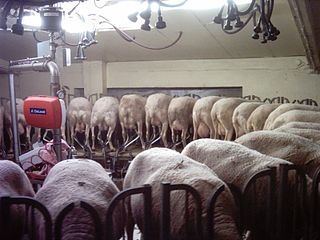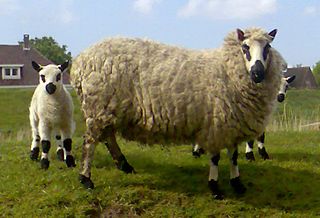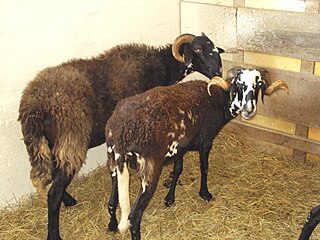Use and raising
The most famous product from Manchega sheep is the Manchego cheese made from their milk. [3] True Manchego cheese must be made from the whole milk of Manchega sheep raised in La Mancha. [3] In La Mancha, Manchego are primarily raised for dairy production, but elsewhere their use is more diversified and they may be raised for meat as well. [1] The Manchega has an annual milk production of about 100 liters (26.2 gallons) a year, [3] with production greatly increasing in the months of April, May, and June, and consequently decreasing the rest of the year. [1] The milking is often done by hand. [5]
In La Mancha, Manchega are typically raised in flocks of 100–600, although herds of up to 2,000 sheep have been known to exist. Typically they are able to graze year-round on the grassy plains of La Mancha, although they may be fed supplementary feeds, especially during lactation or pregnancy. [4] Their feed is often also supplemented in the fall and winter with tendrils from vines and stubble from cropland. [5]
The Manchega's genetics have also played a role in the development of two other breeds: the segureña and talaverana. [2]

Manchego is a cheese made in the La Mancha region of Spain from the milk of sheep of the Manchega breed. It is aged between 60 days and 2 years.
Polwarth is a breed of sheep that was developed in Victoria (Australia) during 1880. They were of one-quarter Lincoln and three-quarters Merino bloodlines. They are large, predominantly polled sheep with long, soft, quite fine wool and produce good meat carcasses. They were developed in an attempt to extend the grazing territory of sheep because the Merino was found lacking in hardiness in this respect. A dual-purpose breed with a major emphasis on wool production. Richard Dennis, of Tarndwarncoort in south west Victoria, bred the Polwarth, first known as Dennis Comebacks. Descendants of Richards Dennis continue to grow Polwarth wool at Tarndwarncoort, maintaining the original bloodlines in a flock referred to as the "Blue Dots".

The Icelandic sheep is a breed of domestic sheep. The Icelandic breed is one of the Northern European short-tailed sheep, which exhibit a fluke-shaped, naturally short tail. The Icelandic is a mid-sized breed, generally short-legged and stocky, with face and legs free of wool. The fleece of the Icelandic sheep is dual-coated and occurs in white and a variety of other colors, including a range of browns, grays, and blacks. They exist in both horned and polled strains. Generally left unshorn for the winter, the breed is very cold-hardy. Multiple births are very common in Icelandic ewes, with a lambing percentage of 175–220%. A gene also exists in the breed called the Þoka gene, and ewes carrying it have been known to give birth to triplets, quadruplets, quintuplets, and even sextuplets on occasion.

Manchego cuisine refers to the typical dishes and ingredients in the cuisine of the Castilla–La Mancha region of Spain. These include pisto, gazpacho manchego, Manchego, the white wine of La Mancha, and the red wine from Valdepeñas (DO).

Zamorano is a sheep's milk cheese made in the province of Zamora, Spain. This is a hard cheese which is typically aged about 6 months. The cheeses are turned often and rubbed with olive oil, giving the cheese its characteristic dark color. This cheese owes its flavor character to the breed of sheep, the "small, scruffy" Churra and the Castilian sheep, predominant in the region, to the cold and humid climate conditions, and to its long aging in cellars.

Sheep's milk is the milk of domestic sheep. It is commonly used to make cultured dairy products such as cheese. Some of the most popular sheep cheeses include feta (Greece), ricotta (Italy), and Roquefort (France).

The Kerry Hill is a breed of domestic sheep originating in the county of Powys in Wales. It derives its name from the village of Kerry (Ceri), near Newtown. Kerry Hill sheep have a distinctive and unique coloration, with a white face bearing black markings around the mouth, ears, and eyes. Both rams and ewes are polled. Their wool is white, and their legs are white with black markings. First mentions of the breed date back to the early 19th century, and today it is distributed throughout the United Kingdom, Ireland, the Netherlands, Germany and Denmark. Though still not very numerous, the breed was removed from the records of the Rare Breeds Survival Trust watchlist in 2006. This breed is primarily raised for meat.

Sheep are quadrupedal, ruminant mammals typically kept as livestock. Like all ruminants, sheep are members of the order Artiodactyla, the even-toed ungulates. Although the name sheep applies to many species in the genus Ovis, in everyday usage it almost always refers to Ovis aries. Numbering a little over one billion, domestic sheep are also the most numerous species of sheep. An adult female is referred to as a ewe, an intact male as a ram, occasionally a tup, a castrated male as a wether, and a young sheep as a lamb.

The Lacaune is a breed of domestic sheep originating near Lacaune in southern France. The native region of these sheep is the Tarn and Aveyron departments and surrounding areas. This region is collectively known as the "Roquefort Sector" which references the milk collection area. The Lacaune is the most widely used dairying sheep breed in France, with a population of about 800,000 ewes. Notably, it is the predominant breed used in the production of Roquefort cheese in France.

The domestic goat or simply goat is a subspecies of C. aegagrus domesticated from the wild goat of Southwest Asia and Eastern Europe. The goat is a member of the animal family Bovidae and the subfamily Caprinae, meaning it is closely related to the sheep. There are over 300 distinct breeds of goat. It is one of the oldest domesticated species of animal, according to archaeological evidence that its earliest domestication occurred in Iran at 10,000 calibrated calendar years ago.

The Beulah Speckled Face is a breed of domestic sheep originating in the United Kingdom. Having been bred in the uplands of Wales for more than a hundred years, a breed society was officially formed in 1958. This breed is most common in Eppynt, Llanafan Fawr, Abergwesyn, and Llanwrtyd Wells, and it is little known outside Wales. The origins of the breed are unclear; it may be a truly native breed that has been selected to suit the local environment for centuries. The breed is named for its distinctly patterned black and white face, which is free from wool. The ewes, which are naturally polled, are often crossed with lowland rams such as the Suffolk, Texel or Bluefaced Leicester to breed mules, and to produce market lambs for meat. When bred pure, the lambs do not meet today's export demand for lean, fast-growing sheep. However, the ewes make good mothers and produce plenty of milk.
The Rideau Arcott is a breed of domestic sheep native to Canada, one of only a few livestock breeds native to the country.

The Latxa is a breed of domestic sheep native to the Basque Country of Spain. Mostly contained within the provinces of Biscay, Gipuzkoa and Navarre, Latxa are dairy sheep whose unpasteurized milk is used to produce Idiazábal and Roncal cheeses. There are two sub-types of the breed, a dark-faced and a blonde.

There are a number of Basque breeds and cultivars. These are domesticated animals that have been bred - or plant species cultivated - for particular traits and features by Basque people in the Basque Country.

Asturian Valley cattle originate from the valleys of Asturias, Spain. They are mostly raised in the northern coastal areas on the Bay of Biscay and the river valleys at the foot of the Cordillera Cantábrica mountain range. This breed belongs to an exclusive bovine group in Spain known as the tronco Cantábrico that only includes breeds native to northern Spain; it also includes the Asturian Valley cattle. of all those breeds, Asturian Valley maintain the largest number. Traditionally the cattle were used for milk, meat, and work. Since other milk breeds have been introduced to Spain, their prominence has declined in the dairy industry. They remain one of three breeds that may be used to produce Casín cheese.

Cheeses in Mexico have a history that begins with the Spanish conquest, as dairy products were unknown in pre-Columbian Mesoamerica. The Spanish brought dairy animals, such as cattle, sheep, and goats, as well as cheesemaking techniques. Over the colonial period, cheesemaking was modified to suit the mixed European and indigenous tastes of the inhabitants of New Spain, varying by region. This blending and variations have given rise to a number of varieties of Mexican cheeses. These are most popular in the country, although European cheeses are made, as well. Almost all cheese in Mexico is made with cows’ milk, with some made from goats’ milk. More recently, efforts have been made to promote sheep's milk cheeses. Most cheeses are made with raw (unpasteurized) milk. Cheeses are made in the home, on small farms or ranches, and by major dairy product firms. Between 20 and 40 different varieties of cheese are made in Mexico, depending on how one classifies them. Some, such as Oaxaca and panela, are made all over Mexico, but many are regional cheeses known only in certain sections on the country. Some of the least common are in danger of extinction.

The Istrian Milk is a breed of domestic sheep native to the regions of Istria and Karst in Croatia. The Istrian Milk is mainly used for its milk, which is primarily used in cheese making. Today, the breed is endangered.

The Rouge du Roussillon is an endangered breed of sheep from southern France. It is primarily raised in the French Mediterranean countryside for lamb meat.

The Xalda is an endangered breed of sheep indigenous to the Asturias province of Northern Spain.
















